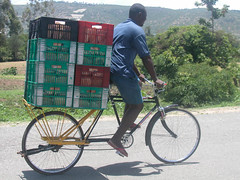In some ways, this post wants you to consider the opposite of my previous post (on the use of airships in aid logistics). Don’t ever let it be said that I am not a fence-sitter.
Airships are great at integrating what was a multimodal[2] (part of a) supply chain into a monomodal one: instead of using various transport means, they could in many cases deliver from origin to destination in one go where before we would have to use several transport means.
However, the use airships for aid is still some time away, and even when it finally arrives there will still be destinations that will be very hard for airships to reach. The most apparent of these are dense urban settings: a large airship, although it needs less landing space than a wide-body plane, still needs considerably more space than e.g. a helicopter. As a large part of aid work takes place in these dense urban settings, we will need to look at other solutions for the last mile. This is all the more true for health logistics: as populations urbanise, more and more of the health effort will need to be concentrated in the cities and towns – and in most developing and middle-income countries these are very densely built up.
The easy solution is of course the tried and true combination of truck and car. However, for various reasons this is actually not appropriate in many settings:
- Cars and trucks are relatively expensive means of transport: not so much in purchase cost (although those are not negligible), but especially in running costs and maintenance.
- Maintenance might not always be possible: especially in developing countries it is at times difficult to find the necessary spare parts or the skills to maintain cars[3].
- Trucks and cars add significantly to air pollution, which is already a problem in many cities in developing and (especially) middle-income countries.
- In the most densely built-up areas, even cars can be impossible to manoeuvre.
So what solutions can we look at?
By far the oldest one is the use of raw manpower: human porters that carry goods wherever they are needed. Obviously, they can get anywhere where people can go, and where labour is cheap this is often the most economical way of transport. However, unless managed very well, porting can be punishing for the people involved, and lead to serious long-term health problems.
 A much better solution is the lowly bike[4]. Like porters, it can get almost anywhere where there are people; if not by riding it, then at least by pushing. It can bear much larger loads (more about that later) but with negligible stress on the body of the biker. And finally, bikes can be repaired by almost any technician worth their salt[5].
A much better solution is the lowly bike[4]. Like porters, it can get almost anywhere where there are people; if not by riding it, then at least by pushing. It can bear much larger loads (more about that later) but with negligible stress on the body of the biker. And finally, bikes can be repaired by almost any technician worth their salt[5].
New developments in bike design mean that they can be used for much heavier and bulkier loads. A good example is the Big Boda load-carrying bicycle, a design from Worldbike. Bikes like this can successfully compete with cars and trucks in many settings, and should be considered seriously when designing logistics systems for health or aid.
(Images by Kees van Mansom and Worldbike.)
Footnotes
[1] If you wonder what I am talking about: have a look at this list of Australian English vocabulary.
[2] Multi-modal transport in this sense refers to transport using more than one means, e.g. train and truck, or ship-train-truck, etcetera. Strictly speaking, the term is reserved for when we have only a single transport contract, but I will use it in a slightly looser sense here.
[3] This is becoming a serious issue as cars are ‘computerised’ and more and more models cannot be maintained without expensive diagnostic machinery and specialised skills and knowledge.
[4] Yes, I am originally Dutch. Why do you ask?
[5] Obviously, I am not talking about your Bernard Hinault Special.



{ 0 comments… add one now }